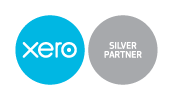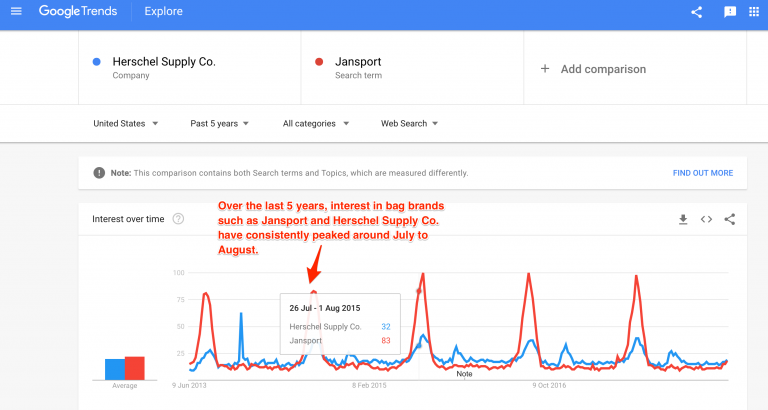To help you capitalize on back to school (aka the second biggest shopping event of the year), we’ve compiled pointers and real-life examples of BTS and BTC marketing best practices you can use as inspiration.
Let’s dive in!
1. Start with the right products
First things first? Make sure your merchandise is on point. Your back to school campaigns won’t be effective if you’re marketing the wrong products. So before crafting your campaigns, be sure to figure out which items to highlight in your store and collateral.
There are two main ways to do this. First is to look at your historical data. Which items were popular during last year’s back to school season? What did people end up buying? You can usually find this information using your POS or retail management system.
In Vend, for example, you can quickly dig into historical reports by selecting a date range and pulling up the numbers for specific products or brands.
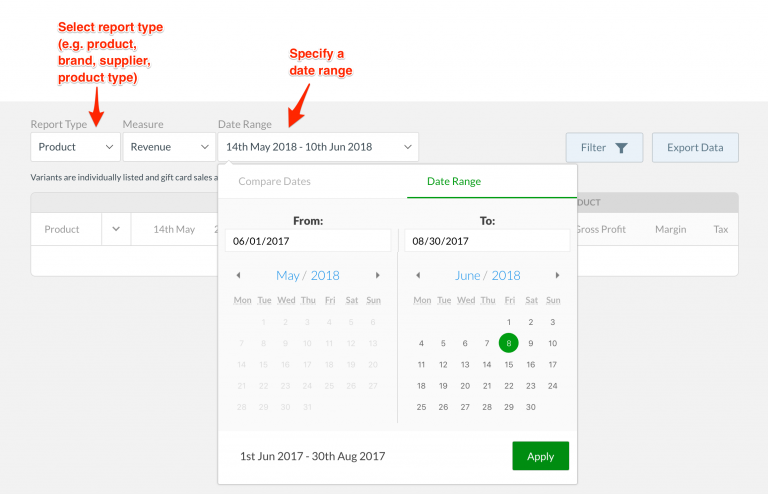
Another way to get product insights is to loom at trends in your market. Google has a free trends tools that can help you do this. Go to trends.google.com and explore trends in your area or niche. You can also enter specific products or brands to view search trends overtime.
For example, if you sell back packs in your shop, you could enter a term like “Herschel Supply Co.” or “Jansport” to gain insights into consumer interest. You can then use that info to determine what to stock and which items to promote in-store and online. (Note: in both cases, search volume has gone up around July to August for the last five years, indicating that consumers do search for these terms around the back to school and back to college shopping periods.
2. Boost sales by demonstrating how your products fit into people’s school lives.
So you’ve stocked up on trendy and useful back to school merchandise. That’s great, but how are you planning to entice shoppers to buy? If your answer is to simply put your products on a shelf or rack, then you’re not going to stand out from the many merchants doing the same thing.
Instead of just putting products out there, showcase your merchandise so they appeal specifically to back to school shoppers. A good way to do this is to point out how people can use your products in school.
If you’re selling say, pens and notepads, consider setting up a desk in your store and show off those products together with other school supplies. If you’re selling furniture, why not showcase your products in a dorm room setting?
If you can’t build an actual dorm room or desk display in-store, then photograph your products in back to school settings and use the images in your marketing collateral.
Here’s a great example from Staples. To market their “classroom essentials,” Staples went beyond displaying their merchandise as standalone products. Instead, the photographed different items together with school props so customers can see how the products can be used in a classroom setting.
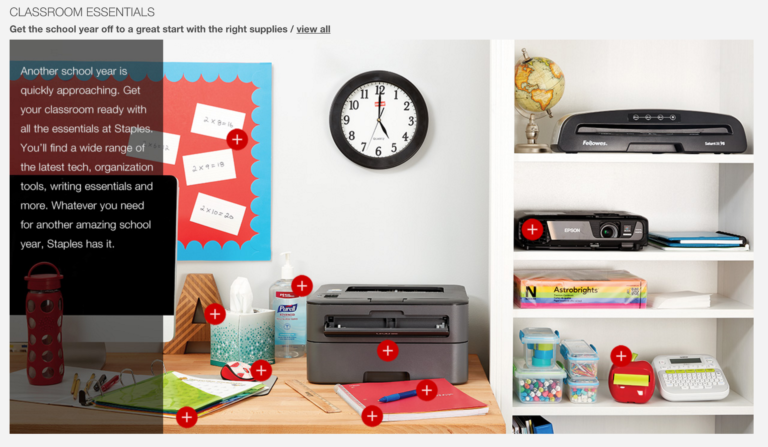
Or check out apparel store Buckle is doing. Rather than just displaying photos of their clothes with generic captions, they’re showcasing back to school outfits to appeal to relevant shoppers.
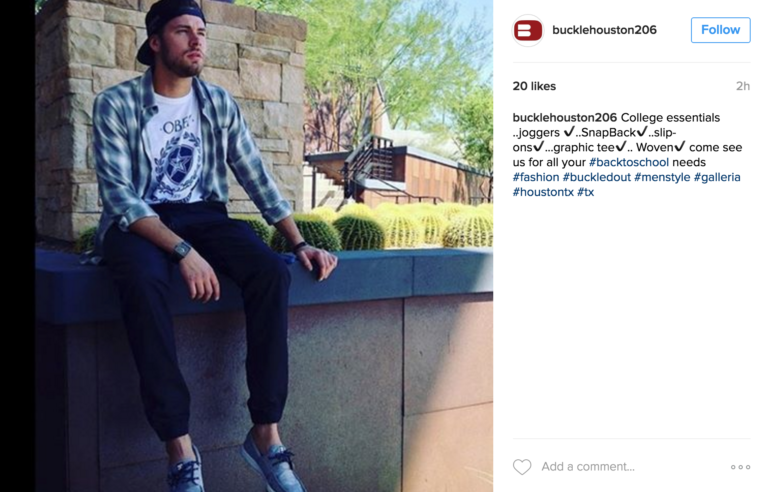
Apply the same thinking to your back to school campaigns. Figure out how your products fit into people’s school lives, and use that as your marketing angle.
3. Make your back to school marketing more relevant to the hottest trends.
What are kids (or even parents) crazy about these days? Think about the latest trends or events that your customers care about and incorporate them into your back to school marketing.
For example, back in 2015, Pokemon Go took both the app world and real world by storm. In response, many retailers rode the Pokemon Go wave to drive sales to stay relevant.
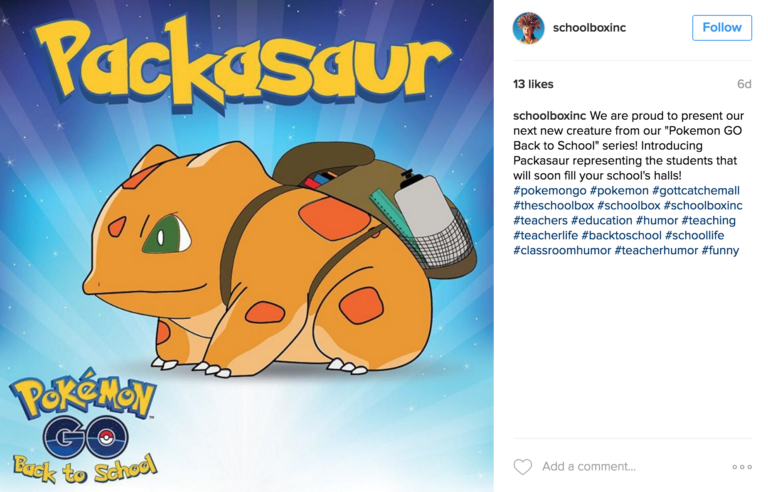
Check out what The School Box did. The retailer launched a Pokemon Go Back to School series where they showed off educational Pokemon-like creatures that they created.
When planning your back to school campaigns, consider incorporating a hot trend to grab people’s attention. Again, you can do some digging on Google Trends to see the latest trending topics. If you’d like to explore the trends and popularity of specific products, you can use Think with Google’s Shopping Insights tool.
4. Make campaigns more compelling by getting the kids involved.
Back to school is about kids, so it makes perfect sense to get them involved in whatever it is you’re doing for the season. This could be as simple as you asking kids and teens what they want to buy for the coming school year, or if you’re serious about involving the kids, why not seek their help in executing your campaigns.
That’s what Target did, and the results were tremendous. For its back to school effort in 2016, the retailer decided to let kids carry out the entire campaign. Children and teens did everything, from writing and directing Target’s ad to creating props and starring in the commercial.
Here’s a behind the scenes look at what happened.
5. Reach more shoppers by marketing on digital channels.
Shoppers are increasingly using online channels to shop for back to school products. Create a unique banner promoting your back to school campaign. And if you can manage it, set up a back to school section on your website, so you have a dedicated space for all your back to school merchandise.
Expect site traffic to increase this season (and continue to do so til the holidays). If you haven’t done so yet, fix any issues that could be causing your site to slow down. These could include unnecessary plugins, images that aren’t optimized, or too much above-the-fold content.
Do note that back to school shopping won’t just take place in-store and online. Mobile shopping is also on the rise this season. A study from The Rubicon Project found that 60% of parents surveyed are “planning to use mobile devices for some back to school shopping” and “30 percent plan to do at least a quarter of their total shopping on mobile devices.”
Needless to say, you need to ensure that you’re providing a superb mobile shopping experience to your customers. Optimize your website, keep an eye out for shortcomings, and strive to provide a seamless experience across channels.
6. Generate buzz through giveaways.
Having a giveaway could be an effective way to generate buzz and excitement around back to school. If you have the time and means to do so, consider running a giveaway that you can promote on social media or even in-store.
You can use the contest to gain buzz and PR, or even to capture people’s information (especially if you’re using raffle tickets or online forms).
Perhaps you could put together a pack consisting of your top back to school products and give it away to people who engage with your brand. Get creative. There are plenty of seasonal giveaways going on right now, use them as inspiration for what to do (or what not to do) in your store.
And to further promote your contest, partner up with social media influencers and brands. Find ways to tap into their audience so you can generate excitement, awareness, and ultimately traffic and sales.
Take a look at what Boogie Wipes did. In 2015, the company teamed up with other brands and bloggers to offer a huge back to school giveaway. Winners took home a backpack filled with school supplies, gift cards, Boogie Wipes products, and more.
7. Team up with mom bloggers or influencers
Speaking of which, teaming up with influencers or bloggers could be a great move for your business.
Back to school season is a great time to get into influencer marketing because parents and kids alike are on the lookout for shopping ideas and you can bet that they turn (at least in part) to influencers. In 2016, a Rakuten Marketing study found that “Almost a third (30%) of parents are willing to spend more on an item of clothing for their child if it has been endorsed by an online influencer” and more than a quarter (27%) “of parents have bought an item after seeing a celebrity’s child wearing it.”
Want to get started with influencer marketing? Do some research into teen influencers that your students are following then see if you can strike up a partnership. Could they wear some of your products and show off some photos to their followers? Would they be willing to collaborate on social media stories and posts? If you’re targeting moms, there’s no shortage of mom bloggers and influencers in the market, so search around a bit and see what you find.
IKEA is one retailer that leveraged influencer marketing for back to school. Last year, the furniture retailer teamed up Mitch Grassi and Scott Hoying (of Superfruit and Pentatonix) and launched a Snapchat campaign featuring their dorm room products.
EcommerceGuide.com offers some helpful tips on influencer marketing that you could apply to your campaign:
- Start with your existing customers
- Tap into micro-influencers
- Use influencer tools such as Peg, Reachbird, Scrunch, etc.
- Build relationships
- Respect the fact that some influencers need to be paid
8. Don’t just push your products, offer something customers could use.
Your campaigns shouldn’t just be about getting people to buy; you should also make it a point to help your customers.
In addition to showcasing your products, find ways to become a helpful resource for back to school consumers. A simple way to do this is to put together back to school tips. Perhaps you can offer a campus survival guide to students. If you’re trying to reach moms, you could offer advice to help them get their kids ready for school faster.
One merchant doing a great job at his is ALDI. The food market has a back to school section on its website that features recipes to help moms save time on busy weekday mornings.
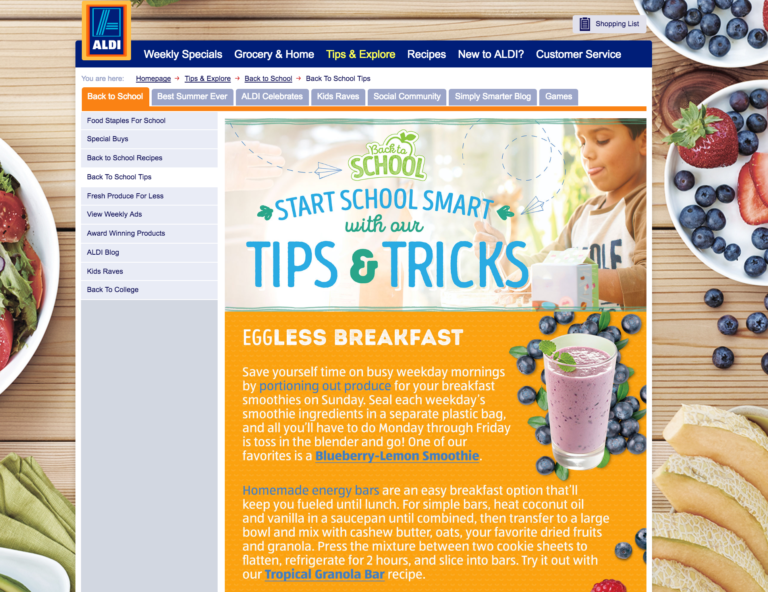
Besides tips and information, you could also provide tools. Why not provide calendars, planners, or templates that people can use in school or at home? Offer them as incentives to add value to each sale, or use them as giveaways.
9. Not selling back to school products? Use “change” as a marketing theme.
Just because you’re not selling traditional BTS products like school supplies, doesn’t mean you can’t use run BTS campaigns.
As retail expert Bob Phibbs says, back to school “is a transition time that brings a harbinger of change. It’s a time of new beginnings, changes in the weather and changes in the way we see ourselves.”
Bob notes that retailers who aren’t selling back to school products can piggyback on this theme by figuring out what this season of change means for their customers. He gives some excellent examples of how stores can use back to school to their advantage.
Consider the following:
- Back to school time for a music store means… time for anyone to learn a new instrument.
- Back to school time for a home improvement center means… time to fix up that forgotten spare room.
These are just a couple of examples. Be sure to check out Bob’s full blog post to learn more about how you can position your store during this season.
Over to you.
We’ve offered several pointers to help you capitalize on this year’s back to school season. Now we’d like to hear from you. How will you engage parents and students who are stocking up for the upcoming school year?
